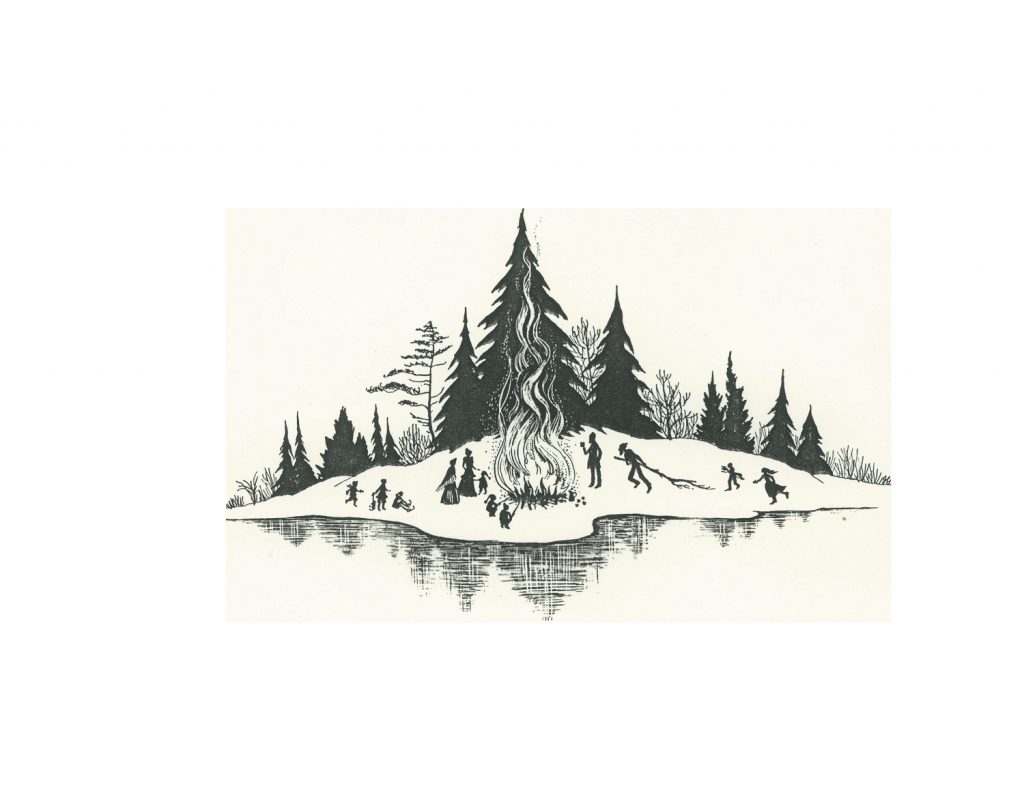By Mary Alice Downie

In this series, we continue with a cheerful miscellany of cooking, gardening, and cellaring for winter.
“The winters [in Quebec] are very healthy, though severe, for since the weather is not changeable, one can take good precautions against the cold. Thus, one takes cold there less than in our country [Germany]. At the beginning of November, people lay in their winter provisions. I was very surprised when people asked me how much fowl, and particularly how many fish, I wanted and where I should like to have the latter left since I had no pond. In the attic, I was told, where they would keep better than in the cellars. Accordingly, I took three to four hundred which kept very well through the winter. All that had to be done when a person wanted meat, fish, eggs, apples, and lemons for the midday meal was to put them in cold water the day before. Thus, the frost is thoroughly removed, and such meat or fish is just as juicy, even more tender than what we have at home. In addition to this, poultry is packed in snow, which forms such a crust of ice that one must chop away with a hatchet.” —Baroness Von Riedesel, Journal from 1776-83.
How strangely this reads in our age of online shopping and capacious refrigerators. But let the furnace go off or the WiFi go down and we envy the general’s wife her well-stocked attic—400 hundred chickens! And roaring log fires. Traditions continue. We still gather provisions for the season and try our hand at a few homemade gifts.
Winter
With luck and a stash of 10-minute treats like Stilton Paté and Viennese Vanilla, the pre-Christmas culinary crunch can be a relatively relaxed affair.
And Christmas shopping, if you don’t view it as a crusade or a wearisome obligation, can be an enjoyable excursion, although perhaps not as colourful a scene as that described by an observer in 19th-century Toronto: “If the weather chanced to be cold, you would see huge files of frozen pigs standing on their four legs in front of the stalls, as if they had been killed when at a gallop; countless sheep hung over-head, with here and there one of their heads carefully gilded, to add splendour to the exhibition. Some deer were almost always noticed at some of the stalls, and it was not unusual to see the carcass of a bear contributing its part to the general show.” —John Geikie Adventures in Canada, 1864.
There is the gradual adornment of the house from Advent Sunday on—cards trickle in and then the tree itself enters the scene, to be decorated with popcorn and cranberry chains, tinsel and ornaments, with the oldest and most battered baubles the most treasured. Lights, wreaths, candy canes. Not only the children are enchanted.
And then, suddenly it’s Boxing Day. With luck, the first forced hyacinth refreshes the jaded household. In January we curl up with seed catalogues while visions of gardens dance in our tired heads. Gradually, the bulbs begin to blossom, the daffodils bring splashes of sunlight to grey days and cheer the sniffling invalids. Someone is always sick in January, but there’s a certain cosiness to sipping a hot toddy together and sharing the commiserations and the Kleenex.
Once recovered, we entertain ourselves with various indoor domestic pursuits: growing little boxes of cress, making marmalade and quick breads. We enjoy substantial peasant soups or red cabbage and sausage after a day on the frozen wastes.
The days grow visibly longer, the snow, once glistening, is piled in grimy heaps by the wayside. And then one afternoon, as we stagger through the mud with the groceries, while the cat waits reproachfully by the front door, through the tattered snow pokes the first snowdrop. Spring!
Flavoured Sugars
The Romans used sugar for medicine; honey was their sweetener. The Medieval English, on the other hand, revelled in all sorts of sugars, plain and fancy, including violet and rose. You can make them too, but for now, try these.
Vanilla Sugar: Put a vanilla bean in a jar, fill with granulated sugar and cover. Let it stand for at least three days.
Cinnamon Sugar: Mix 1/4 cup (50 ml) cinnamon with 2 cups (500 ml) granulated sugar. It’s handy to have this ready-mixed on the shelf for making the perennial winter favourite, cinnamon toast, or for sprinkling on coffee cakes, streusel and apple pies.
Flavourings
Vanilla Extract: put a vanilla bean in a small bottle and cover it with brandy. Let it stand for five days until the flavour permeates and then use.
Viennese Vanilla: For a subtle flavouring that is particularly good with whipped cream, mix 1/4 cup (50 ml) vanilla extract with 2 tbsp. (25 ml) almond flavouring. Use in the same proportions as you would regular vanilla.
Pickled Eggs
A brightly coloured French-Canadian variant of the old standby.
12 hard-boiled eggs
1 cup (250 ml) canned beet juice
1 cup (250 ml) cider vinegar
1 clove garlic
1 bay leaf
1 tsp. (5 ml) salt
1/4 tsp. (1 ml) pepper
While peeling the eggs, bring the beet juice, vinaigrette and spices to a boil in a small saucepan. Put the eggs in a large glass jar and pour over the juice. Cover the jar, let the eggs cool and chill for at least 24 hours. The longer the better. Serve them whole, sliced in salads, or as an appetizer on wholewheat crackers with a touch of anchovy paste, they will keep in the refrigerator for at least two months. (One of life’s small pleasures is having your own bay tree in the kitchen, for a constant supply of leaves. Perhaps ask for one for Christmas.)
Stilton Paté
Spread this rich creamy mixture on crackers and your guests will not complain. This also freezes well.
1/2 cup (125 ml) Stilton cheese
1/2 cup (125 ml) butter
1/2 cup (125 ml) cream cheese
2 large cloves garlic, minced
Mash everything together in a small bowl until well blended, or blend in a food processor. Store the paté in the refrigerator in a small, covered container. Before serving on crackers or pumpernickel bread, allow it to soften slightly. Makes about 1 1/2 cups (375 ml).
Cheddar Port Dip
Somewhat like the Stilton paté, and somewhat cheaper, is this mixture which can also be spread on crackers and used in sandwiches.
1/3 cup (125 ml) sherry or port
1/2 cup (125 ml) cream
1 tbsp. (15 ml) chopped chives or green onion
8 oz. (250 g.) old Cheddar cheese, diced
Blend all ingredients on high speed in a blender or food processor until smooth. Store in small crocks in the refrigerator. Makes 1 cup (250 ml). Small children, in our experience, detest Christmas
pudding. One sensible grandmother took care to have ice cream bars as a pleasing alternative. Adults might prefer these lighter delights.
Fluffy Sauce
Serve it over frozen strawberries, slightly warmed in the oven, and you have a winter version of Fraises Romanoff.
1 cup (250 ml) whipping cream
4 egg yolks
1/2 cup (125 ml) granulated sugar
1/4 tsp. (1 ml) salt
1/3 (75 ml) sherry
Beat the whipping cream in a small bowl until stiff. In another bowl beat the egg yolks with the remaining ingredients until very light and foamy. Fold the mixture gently into the whipped cream and serve at once over fruit or pudding. Makes about 2 cups (500 ml).
Syllabub
The quickest and simplest of milky desserts—and perhaps the best, with the benefit that you can make it the day before the hurly-burly of the battle with the turkey.
1 1/4 cups (300 ml) whipping cream
1/3 cup (75 ml) lemon juice
1/4 cup (50 ml) rum, sherry or whisky
3 tbsp. (15ml) granulated sugar
1 egg white
Whip the cream until it stands in soft peaks. Gently fold in the lemon juice, liquor and sugar. Beat the egg white until stiff and fold into the cream. Pour into individual glass serving dishes and refrigerate for 24 hours. Serves 8. “I often used to put mint leaves into my tea to correct the taste of the foul swamp-after,” wrote the Earl of Sothesk (Saskatchewan and the Rocky Mountains, 1875). He should have tried instead:
Hot Toddy
A brother-in-law with a cold, given this stern Scottish brew, retired to his bed and slept for twelve hours. “If you want to enjoy it,” said our source, “dress it up with a little lemon juice. If you just want to get rid of your cold, take it straight.”
1/4 cup (50 ml) scotch
1 tsp. (5 ml) granulated sugar
1/4 cup lemon juice (50 ml) optional
Mix the ingredients in a glass or mug with a silver spoon in it, to prevent cracking. Pour in very hot, not boiling water, from a tea kettle, not from the tap. Stir and serve.
Mary Alice Downie is the author of 28 books for children and adults. This story is harvested from The Well-filled Cupboard: Everyday Pleasures of the Canadian Home and Garden (not my favourite title) by MAD and Barbara Robertson. (Lester & Orpen Dennys, 1987, reprinted by Fitzhenry & Whiteside, 2000 pb.






